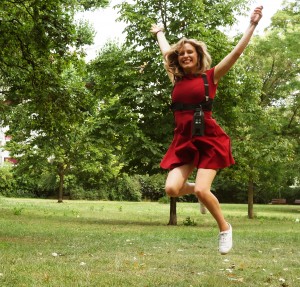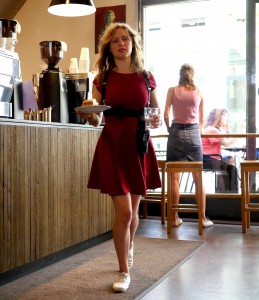PARAlife
 Claudia Diana Eichler, Physiotherapeutin
Claudia Diana Eichler, Physiotherapeutin
Innovative stimulation therapy for neuro-orthopedic illnesses
Giving up is not your thing: Distressed parents who have received a diagnosis for their child which makes carefree life impossible, search for new ways and develop unconventional concepts in line with the principal of cause and effect.
The tenacity to swim against the current and consistently go public in order to share information with other affected people, is done by a few of you, to increase product maturity and market availability.
This is how the englishman, Rupert Isaacson developed an equestrian based therapeutic concept for his autistic son, to improve his communication skills, train his learning ability and to free him from his fears and compulsions. In his books “The Horse Boy” and “The Long Ride Home” the author powerfully depicts Rowan’s positive development. He had previously been diagnosed as a hopelessly disabled boy.
It was similar for Anna Vonnemann-Gutmann, whose daughter Dindia was born with one sided paralysis as a result of a pre-natal hypoxia (oxygen deficiency during pregnancy).
A childhood full of physiotherapy, pain, hip operations, hopeless prognoses of never being able to walk and a life in a wheelchair without any autonomy, challenged the spirit of the artist and she entered unfamiliar territory. This resulted in the development of a small device, which increased her daughter’s sense of orientation whilst standing and during gait training via a spatial fixed point.
She began with a torch. Dindia had to hold the ray of light straight. She increasingly began to search for other effective sensory stimuli.
Every year in Berlin there is a Science Night and Anna Vonnemann-Gutmann went with her daughter and her development to the Technical University. She looked for an adept developer in the field of medical technology and found the perfect partner in Dr. Ing. Wolfram Roßdeutscher.
Together they developed a biofeedback system controlled by a microprocessor, which warned Dindia with an electrical pulse if she lost her center of balance or began to sway while walking. Dindia quickly learnt how to use the impulse as a aid: An aid which gave the networking of her motor cortex and her sense of balance a helping hand. One day she wanted to be able to jump!
A Canadian businessman in the medical field was coincidentally at Anna’s presentation of the device and was so deeply touched by the results Dindia achieved with her first small biofeedback device, which was held in a lunchbox, that he immediately told his German friend about it. Professor Dr. med. Frank Duesberg, a specialist in physical, rehabilitative medicine and orthopedics, who lectures in medical technology, immediately recognised the development’s potential and committed himself to its implementation in practice.
The specialist in neuro orthopedics is of the opinion that the stimulation devices with vibration stimulus currently used in some cases in the field of posture optimisation do not give off a strong enough impulse to reach the required sensitivity threshhold.
The Remember Motion Device, abbreviated to ReMoD, has outstanding current forms which do not directly stimulate the neurogenic hypertonic (spastic) muscle, but rather send a reminding effect above the autonomous nervous system directly to the centers in the brain which store information about the automatism of our actions and movement.
In this way newly learned symmetry can be directly, effectively and neurophysiologically supported in the cases of Hemisparesis patients, for the repositioning of the spine in poorly postured youths, for older people threatened with osteoporosis and during gait training for semi paralysed paralegics and tetraplegics.
The latest findings in the field of brain research show how infinitely crosslinked all centers of the brain are. Learning ability is thereby encouraged by movement, posture has an influence on our internal attitude and a stable, well trained spine is more resistant to stress and just not as easily bent.
“The evolutionary straightening of humans has swiftly facilitated huge development of the brain, but it also requires continuous impulses to stay upright, in order to develop these abilities and make use of them.” This mindset along with the increasingly apparent problems that his patients had, led Professor Duesberg to medical technological developments, which comprehensively detect postural misalignments in 3D.His differentiated analysis systems help people to detect tensions in their body which impair posture, without radiation.
The available medical options such as system orientated therapy methods of physiotherapy, manual medicine, including osteopathy and neurophysiological movement concepts based thereon, can causally cure such disorders on a long term basis.
ReMoD is an invaluable innovation to finally stabilise these ardously aqcuired qualities through neurogenic programming and to make them available for regular use in the long run.
A lot of initiative, funding by the European Union, the Federal Ministry of Economics and Technology and the ESF, the European Social Fund for Germany and the the continuing constructive criticism of Dindia, who is now an Economics student, led to the creation of a production-ready therapy device.
The practicality of the device has been put to the test by it’s excited user and her industrious desire to travel in Israel, Portugal and now during her master degree in Amsterdam.
Training everyday for about an hour with the ReMoD-device and a specific gym program, which draws on the latest findings in brain research, has led to Dindia having an approximate physiological gait pattern with which she moves freely and confidentally down the street and in nightclubs, she undertakes kilometer long hikes and can lead her life completely independently anywhere in the world.
It is the firm opinion of the student that “other affected people could also manage this reasonable effort.” She has long forgotten the wheelchair. Her biggest goal, to jump, which was unattainable during childhood, is now thankfully one of her favourite rituals.
Further information:
Caremont Unternehmergesellschaft
Bahnhofstr. 35a, D-42651 Solingen
Tel.: 0212-38229877 – Fax: 0212-2215113

